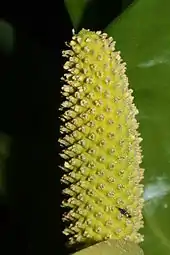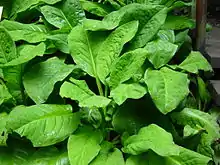Lysichiton americanus
Lysichiton americanus, also called western skunk cabbage (US), yellow skunk cabbage (UK),[1] American skunk-cabbage (Britain and Ireland)[2] or swamp lantern,[3] is a plant found in swamps and wet woods, along streams and in other wet areas of the Pacific Northwest, where it is one of the few native species in the arum family. The plant is called skunk cabbage because of the distinctive "skunky" odor that it emits when it blooms. This odor will permeate the area where the plant grows, and can be detected even in old, dried specimens. The distinctive odor attracts its pollinators, scavenging flies and beetles. Although similarly named and with a similar smell, the plant is easy to distinguish from the eastern skunk cabbage (Symplocarpus foetidus), another species in the arum family found in eastern North America.
| Lysichiton americanus | |
|---|---|
 | |
| Scientific classification | |
| Kingdom: | Plantae |
| Clade: | Tracheophytes |
| Clade: | Angiosperms |
| Clade: | Monocots |
| Order: | Alismatales |
| Family: | Araceae |
| Genus: | Lysichiton |
| Species: | L. americanus |
| Binomial name | |
| Lysichiton americanus Hultén & H.St.John | |
| Synonyms | |
| |
Description

The plant grows from rhizomes that measure 30 cm or longer, and 2.5 to 5 cm in diameter. The short-stalked leaves are the largest of any native plant in the region, 30–150 cm long and 10–70 cm wide when mature. Its flowers are produced in a spadix contained within a 7–12 cm, large, bright yellow or yellowish green spathe atop a 30–50 cm stalk. The flowers are numerous and densely packed. It is among the first flowers to bloom in late winter or early spring.[4][5][6] Unlike the genus Symplocarpus (which includes S. foetidus, the eastern skunk cabbage), the flowers of Lysichiton species do not produce heat,[7] although this is widely and incorrectly said to be the case.[8]
Distribution
L. americanus is found from Kodiak Island and Cook Inlet, Alaska south through British Columbia, Washington, Oregon, and Northern California as far south as Santa Cruz County. Isolated populations are also found in northeastern Washington, northern Idaho, Montana, and Wyoming.[9][10]
The plant was introduced into cultivation in the United Kingdom in 1901 and has escaped to become naturalized in marshy areas in Britain and Ireland, for example in Hampshire and Surrey, including Wisley Gardens, and in the north and west of the UK.[11] In 2016, it was classified by the European Union as an invasive non-native plant species.[12]
Cultivation
It was used as an ornamental garden plant in Britain and Ireland, where it grows well in marshy conditions. As of 2018, the Royal Horticultural Society recommends that it should not be cultivated.[13]
Hybrids with Lysichiton camtschatcense, called Lysichiton × hortensis, are also cultivated. These have larger spathes than either of the parents.[11]
Other uses
While some consider the plant to be a weed, its roots are food for bears,[14] who eat it after hibernating as a laxative or cathartic. Deer may browse the leaves.[14]
The plant was used by indigenous people as medicine for burns and injuries, and for food in times of famine, when the leaves were heated and eaten.[14] The leaves have a somewhat spicy or peppery taste. The plant contains calcium oxalate crystals, which result in a prickling sensation on the tongue and throat[14] and can result in intestinal irritation and even death if consumed in large quantities. Although the plant was not typically part of the diet under normal conditions, its large, waxy leaves were important to food preparation and storage. They were commonly used to line berry baskets and to wrap around whole salmon and other foods when baked under a fire. It is also used to cure sores and swelling.

See also
- Lysichiton camtschatcensis (Asian skunk cabbage): a related plant from north-east Asia, but not known for producing a foul smell
- Symplocarpus foetidus (eastern skunk cabbage): although not in the same genus, it is often confused with western skunk cabbage
- Calla palustris (bog arum): a similar plant grown as an ornamental herbaceous perennial
References
- RHS A-Z encyclopedia of garden plants. United Kingdom: Dorling Kindersley. 2008. p. 1136. ISBN 978-1405332965.
- "BSBI List 2007". Botanical Society of Britain and Ireland. Archived from the original (xls) on 2015-01-25. Retrieved 2014-10-17.
- E-FLORA BC: Electronic Atlas Of The Flora Of British Columbia, Lab for Advanced Spatial Analysis, Department of Geography, University of British Columbia, Vancouver.
- Klinkenberg, Brian, ed. (2014). "Lysichiton americanus". E-Flora BC: Electronic Atlas of the Plants of British Columbia [eflora.bc.ca]. Lab for Advanced Spatial Analysis, Department of Geography, University of British Columbia, Vancouver. Retrieved 2015-06-16.
- Giblin, David, ed. (2015). "Lysichiton americanus". biology.burke.washington.edu. Burke Museum, University of Washington. WTU Herbarium Image Collection. Retrieved 2015-06-16.
- "Lysichiton americanus". Jepson eFlora: Taxon page. Jepson Herbarium; University of California, Berkeley. 2015. Retrieved 2015-06-16.
- Halevy, Abraham H. (July 23, 2019). Handbook of Flowering Volume VI. CRC Press. p. 421. ISBN 9781351081030.
- See as one example "Lysichiton americanus". Learn 2 Grow. Archived from the original on 2013-12-03. Retrieved 2012-12-04.
- Sullivan, Steven. K. (2015). "Lysichiton americanus". Wildflower Search. Retrieved 2015-06-16.
- "Lysichiton americanus". PLANTS Database. United States Department of Agriculture; Natural Resources Conservation Service. 2015. Retrieved 2015-06-16.
- Armitage, James D. & Phillips, Barry W. (2011), "A hybrid swamp lantern", The Plantsman, New Series, 10 (3): 155–157
- "List of Invasive Alien Species of Union concern". European Commission. Retrieved 1 May 2018.
- "RHS Plant Selector - Lysichiton americanus". Archived from the original on 3 December 2013. Retrieved 1 May 2018.
- Fagan, Damian (2019). Wildflowers of Oregon: A Field Guide to Over 400 Wildflowers, Trees, and Shrubs of the Coast, Cascades, and High Desert. Guilford, CT: FalconGuides. p. 101. ISBN 1-4930-3633-5. OCLC 1073035766.
External links
- Flora of North America: Lysichiton americanus
- Native American Ethnobotany: Lysichiton americanus
- UBC Botanical Garden and Centre for Plant Research: Lysichiton americanus
| Wikimedia Commons has media related to Lysichiton americanus. |
